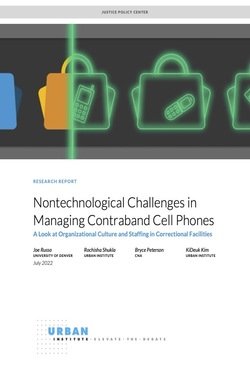By John Shaffer, Bryce Peterson, KiDeuk Kim, Rochisha Shukla
Cell phones have become a ubiquitous part of society, with more than 97 percent of US adults owning one (Pew Research Center 2021). For prison and jail officials, however, they represent a serious and growing concern. In a recent survey of state correctional agencies, Urban found that most respondents consider cell phones a serious problem for a facility’s overall security and for the safety of incarcerated people, staff, and members of the public (Kim, Peterson, and Shaffer 2023). Corrections officials have employed several technological and nontechnological solutions to address contraband cell phones in their institutions (Peterson et al. 2022; Russo et al. 2022). No one strategy appears to be completely effective at combating contraband cell phones. Most strategies are limited in their ability to prevent cell phone use across an entire facility, while others are difficult to implement or prohibitively expensive (see Peterson et al. 2022). Conversely, signal jamming has received broad support among criminal justice practitioners as a potentially effective and straightforward interdiction strategy. Officials can use signal jamming to prevent people from using cell phones throughout their facilities by compromising a phone’s ability to receive signals or by modifying received signals to be inaccurate or inoperable. A typical application of cell phone jamming involves overwhelming the phone with a higher-power signal, usually a pure signal or random noise, so the phone can no longer function properly. Although many corrections officials are interested in implementing signal jamming in their agencies, the Federal Communications Commission currently prohibits the use of this technology in the United States, as guided by the Communications Act of 1934. Some federal agencies are exempt from the Communications Act and are allowed to implement jamming solutions by requesting and receiving Special Temporary Authority licensing from the Federal Communications Commission. The Federal Bureau of Prisons is among these agencies. No state or local entities are currently allowed to use signal jamming technology. The selective prohibition against jamming has been a source of tension between federal regulators and corrections officials, and federal lawmakers have made efforts (for instance, through the Cellphone Jamming Reform Act of 2022) to revise the Communications Act and allow state correctional agencies to jam cell phones. Despite corrections officials’ interest in jamming and the ongoing discussion around legislative changes, little is known about the use and application of this technology in correctional settings. To address this knowledge gap, the Urban Institute, along with partner organizations (CNA Corporation, Correctional Leaders Association, and American Correctional Association) and subjectmatter experts (John Shaffer and Joe Russo), reviewed current industry practices and interviewed officials with firsthand experience implementing jamming. In summer and fall 2021, we spoke with corrections officials in the United States, New Zealand, and Australia to formulate an understanding of the benefits and challenges of cell phone jamming as a cell phone interdiction strategy.2 This report is a resource for stakeholders and the public on the mechanics of jamming, its potential effectiveness, and the legal and pragmatic considerations involved in its implementation in correctional settings
Washington DC: The Urban Institute, 2023. 18p.
















